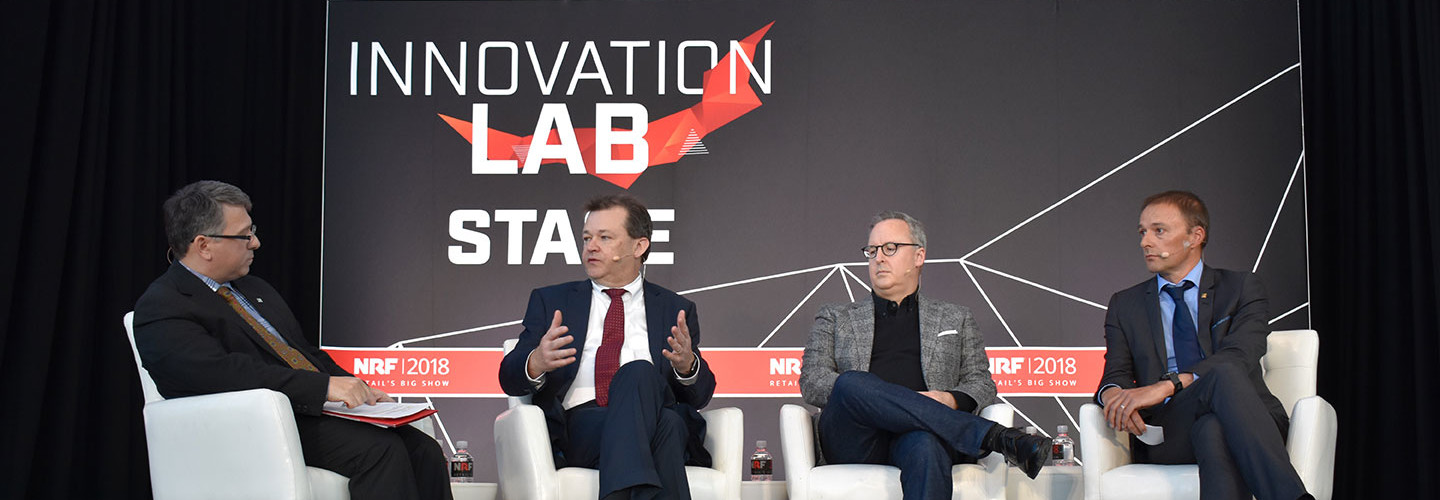Want Digital Transformation in Retail? Break Down Internal Silos
If retailers want to achieve digital transformation, they should focus more on the transformation part and then figure out where digital fits in.
Retailers should break down barriers between IT and the business side of the company and determine how they can use technology to improve the business, retail IT leaders and experts said during a panel on digital transformation at NRF 2018: Retail’s Big Show in New York City on Jan. 14.
Even before Neiman Marcus tasked Scott Emmons with creating and directing its Innovation Lab in 2012, the luxury retailer realized that its online business was being run totally separately from its physical retail business. That needed to change. Now, Neiman Marcus is widely recognized as a leader in retail digital transformation.
“We did go all in on the idea that our customers didn’t think about it differently,” Emmons said during the panel discussion. “We knew we had a lot of work to do to pull those experiences together.”
Neiman Marcus has been an e-commerce trailblazer, focused on transferring those capabilities to their physical stores in ways that solve customers’ problems, Emmons said.
A key goal of digital transformation, according to Emmons, is breaking down silos, like those that existed at Neiman Marcus, where IT was walled off from business operations. “We had to break out of that [approach of] sitting around waiting for business to come up with lots of ideas that we couldn’t execute on,” he said. IT needed to be part of the ideation and planning process with the business side of the house “so we could build our ideas along with what the business was thinking.”
SIGN UP: Get more news from the BizTech newsletter in your inbox every two weeks!
What Is Digital Transformation in Retail?
It’s a hot topic in the technology world, but what does digital transformation mean for retailers?
Leslie Hand, vice president for IDC Retail Insights, says that digital transformation in retail means more than simply adding digital technologies to the standard business plan. Instead, retailers need to rethink their business models, organizational structure, talent strategies, information management and the “technologies and processes by which you engage the customer.”
More than half of retailers say they are at some active stage of digital transformation, Hand says. Most often, she says, retailers focus on technology and do not turn their business model on its head.
“They start with these tactical solutions to target their customers or improve e-commerce or deploy better market strategies,” she says. “In order to maintain a pace of innovation that is going to attract and retain those customers, they need to think more strategically.”
Retailers that want to undertake digital transformation should think less about specific technology solutions and more about their business overall, Hand advises. “Take a step back and think about who your customers are and what they really expect of you. Who do you want your customer to be, and who do you need to be in order to satisfy that customer’s needs?”
Panel participant David Cost, vice president of e-commerce and digital marketing at Rainbow Apparel, described how the company is using technology to make the shopping experience easier for customers. Rainbow has about 1,100 physical stores, and 45 percent of purchases are made with cash. Obviously, it’s not possible to take a cash order online, he said, so the company is developing technology that will allow customers to order online and then pay in-store.
After placing an order online, customers will have 48 hours to go to a physical store and pay for it, Cost said. If they don’t show up, the company will cancel the order.
Cost said retailers need to embrace new forms of mobile payment and break down barriers that prevent customers from completing transactions.
Use Technology to Solve Problems For Retail Customers, Employees
Jean-Baptiste Branquart, vice president of retail at consultancy CGI, told panel attendees that customers around the world desire “a seamless experience” and expect to be able to use whatever retail channel they want, when they want to. Above all, retailers must compete on price and offer value to customers, he cautioned.
Because of internal silos at retailers, customers still face obstacles to seamless omnichannel retail experiences, Rainbow Apparel’s Cost said: “The way things are set up internally is the biggest impediment to a true omnichannel vison.”
For example, at Rainbow, if a customer returned an online purchase to a physical store, that return would ring up as a negative sale. Sales associates, whose bonuses are based on sales, did not like processing such transactions, Cost said. To solve the problem, Rainbow decided to change its internal processes and attribute online sales to stores based on the ZIP code to which orders were shipped. “So, sales associates feel the benefit of the sale, not just the pain of the return,” he added.
As retailers continue to search for new ways to leverage technology and innovate faster, Emmons said, they need to stick to their core principles and focus on customers’ needs and business issues. “Look for technology that actually solves a real problem,” instead of just being novel, he said.
Technology must make life easier and better for customers and sales representatives, he added: “I’m not interested in chasing the new and shiny if I don’t have an actual problem that it solves for me.”
For our full array of articles and videos from the conference, check out BizTech’s coverage of NRF 2018 conference here.








